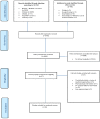Systematic review of rehabilitation intervention outcomes of adult and paediatric patients with infectious encephalitis
- PMID: 29764868
- PMCID: PMC5961616
- DOI: 10.1136/bmjopen-2017-015928
Systematic review of rehabilitation intervention outcomes of adult and paediatric patients with infectious encephalitis
Abstract
Objective: Although a range of rehabilitation interventions have been applied to restore function after infectious encephalitis, there is a lack of literature summarising the benefits of these interventions. This systematic review aims to synthesise current scientific knowledge on outcome measures following rehabilitative interventions among children and adults with infectious encephalitis, with a specific focus on the influence of the age, sex, baseline status and intervention type.
Search strategy: Five scholarly databases (MEDLINE, Embase, PsycINFO, CINAHL and Cochrane Central Register of Controlled Trials), three sources of grey literature (Google, Google Scholar and Grey Matters) and reference lists of included publications were systematically searched. Literature published before 15 December 2017 and focused on patients with infectious encephalitis in any rehabilitation setting were included. Quality assessment was completed using the Downs and Black rating scale.
Results: Of the 12 737 reference titles screened, 20 studies were included in this review. All of the studies had sample sizes of less than 25 patients and received a score of less than 15 out of 31 points on the Downs and Black rating scale. Findings showed a variety of interventions has been applied to alleviate sequelae from infectious encephalitis, including using cognitive therapy (nine studies), behavioural therapy (five studies), physical therapy (two studies) or two or more therapies (four studies). There was inconclusive evidence on the effect of sex, age and baseline functional abilities on outcomes. Due to clinical and methodological heterogeneity between studies, meta-analyses were not performed.
Conclusion: Evidence suggests the potential for a beneficial effect of rehabilitation interventions in patients with infectious encephalitis. Future research is required to identify all effect modifiers and to determine the effect of time in the natural course of recovery. An enhanced set of known effect modifiers will support the process of future evaluation of a client-centred rehabilitation intervention.
Trial registration number: CRD42015029217.
Keywords: infectious encephalitis; intervention; non-traumatic brain injury; rehabilitation; rehabilitation outcome.
© Article author(s) (or their employer(s) unless otherwise stated in the text of the article) 2018. All rights reserved. No commercial use is permitted unless otherwise expressly granted.
Conflict of interest statement
Competing interests: None declared.
Figures

Similar articles
-
Rehabilitation interventions in children and adults with infectious encephalitis: a systematic review protocol.BMJ Open. 2016 Mar 24;6(3):e010754. doi: 10.1136/bmjopen-2015-010754. BMJ Open. 2016. PMID: 27013598 Free PMC article.
-
Behavioural modification interventions for medically unexplained symptoms in primary care: systematic reviews and economic evaluation.Health Technol Assess. 2020 Sep;24(46):1-490. doi: 10.3310/hta24460. Health Technol Assess. 2020. PMID: 32975190 Free PMC article.
-
Beyond the black stump: rapid reviews of health research issues affecting regional, rural and remote Australia.Med J Aust. 2020 Dec;213 Suppl 11:S3-S32.e1. doi: 10.5694/mja2.50881. Med J Aust. 2020. PMID: 33314144
-
The future of Cochrane Neonatal.Early Hum Dev. 2020 Nov;150:105191. doi: 10.1016/j.earlhumdev.2020.105191. Epub 2020 Sep 12. Early Hum Dev. 2020. PMID: 33036834
-
Psychological interventions to improve self-management of type 1 and type 2 diabetes: a systematic review.Health Technol Assess. 2020 Jun;24(28):1-232. doi: 10.3310/hta24280. Health Technol Assess. 2020. PMID: 32568666 Free PMC article.
Cited by
-
Experience in Rehabilitation Treatment for Patients Repeatedly Admitted to Intensive Care Units After Dual Graft Living-Donor Liver Transplantation: A Case Report.Cureus. 2025 Jan 7;17(1):e77099. doi: 10.7759/cureus.77099. eCollection 2025 Jan. Cureus. 2025. PMID: 39917158 Free PMC article.
-
Eastern equine encephalitis virus: Pathogenesis, immune response, and clinical manifestations.Infect Med (Beijing). 2025 Jan 17;4(1):100167. doi: 10.1016/j.imj.2025.100167. eCollection 2025 Mar. Infect Med (Beijing). 2025. PMID: 40026316 Free PMC article. Review.
-
Need for neurorehabilitation in the Middle East and North Africa from 1990 to 2021: an analysis based on the global burden of disease study.Ann Med Surg (Lond). 2024 Sep 24;86(11):6422-6432. doi: 10.1097/MS9.0000000000002583. eCollection 2024 Nov. Ann Med Surg (Lond). 2024. PMID: 39525781 Free PMC article.
-
Clinical Spectrum and Dynamics of Sequelae Following Tick-Borne Encephalitis Virus Infection: A Systematic Literature Review.Open Forum Infect Dis. 2025 May 29;12(6):ofaf317. doi: 10.1093/ofid/ofaf317. eCollection 2025 Jun. Open Forum Infect Dis. 2025. PMID: 40568008 Free PMC article.
-
Urogenital Manifestations in Mpox (Monkeypox) Infection: A Comprehensive Review of Epidemiology, Pathogenesis, and Therapeutic Approaches.Infect Drug Resist. 2025 Jan 10;18:209-226. doi: 10.2147/IDR.S504280. eCollection 2025. Infect Drug Resist. 2025. PMID: 39816240 Free PMC article. Review.
References
-
- National Institute of Neurological Disorders and Stroke (NINDS). Meningitis and encephalitis fact sheet. http://www.ninds.nih.gov/disorders/encephalitis_meningitis/detail_enceph... (accessed 15 Dec 2015).
-
- Association of American Medical Colleges. Infectious Disease, Internal Medicine. https://www.aamc.org/cim/specialty/list/us/339608/infectious_disease_-in... (accessed 19 Nov 2015).
Publication types
MeSH terms
Grants and funding
LinkOut - more resources
Full Text Sources
Other Literature Sources
